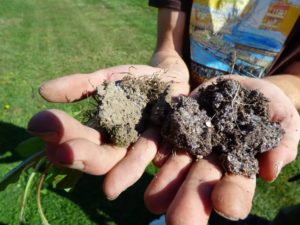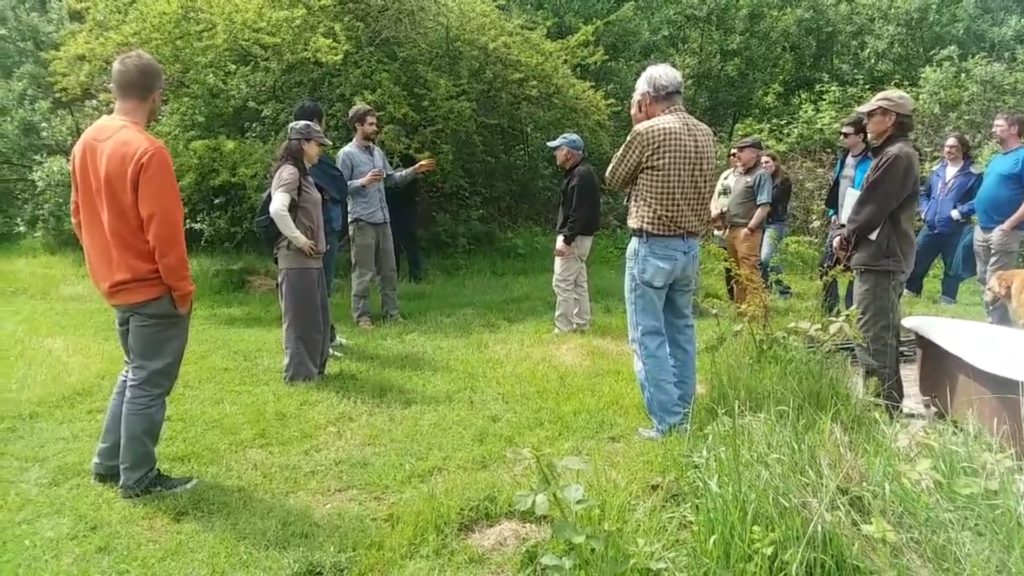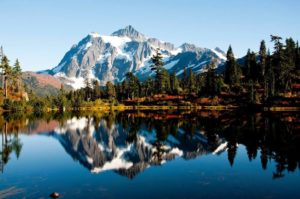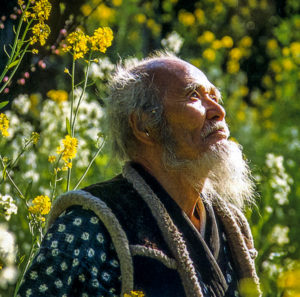Peter Jackson on Natural Farming, Ecological Resilience, and the Magic of Minerals and Microbes
Over a span of nearly two decades, self-taught natural farmer Peter Jackson has transformed a plot of rural Washington land into a thriving, bountiful forest garden.
When his family first arrived on the land nearly twenty years ago, it contained only a few food-bearing plants: old heirloom apple trees, sickly pear trees, and Chinese plum trees with cherry-sized fruits. Today, the property is home to approximately three hundred fruit and nut trees, as well as assorted berry bushes, and Jackson isn’t finished yet. “I’m trying to get up to about 500 trees on the four and a half acres,” he says.
In addition to his farming work, Jackson is the founder of Cascadian Natural Farming, an organization that aims to educate the public about the philosophy and practices of natural farming through workshops, soil consultations, and conferences. His next conference, “Online International Nature Farming Convergence,” is slated for December 2 – 5, 2021, and will feature speakers from across the United States and Asia, delivering talks on soil health, remineralization, food fermentation, and more.
Jackson’s education in regenerative farming techniques began decades ago, during his childhood in Anacortes, Washington, a town of 16,000 located on Fidalgo Island in the Puget Sound. As a child, his backyard was host to fruit trees and vegetable gardens, and his parents practiced composting. He also recalls witnessing a neighbor burying filleted fish heads and guts beneath the potato and rose plants in her yard. The sight instilled in him an “understanding that you have to put something back into what you’re taking [from].”
Jackson carried this ethos with him into his high school years, when he began making his own gardening soils by combining chicken manure and compost. At age eighteen, he left Anacortes to travel the world, working on organic farms in New Zealand, California, Costa Rica, and Hawaii. Through his travels, he learned about permaculture, a philosophy of land management and design practices founded on Indigenous values and knowledge with the goal of fostering sustainable, ecologically harmonious relationships between humans and the environment.
Upon returning to Washington in 2011, Jackson began researching alternative farming methods. “I’ve never done any sort of apprenticeship or teaching or anything,” he says. “It’s all really just been my own self-study and experimentation. And lots of online interaction with some really knowledgeable people.” He describes himself as more of a natural farmer than a permaculturist, a realization he came to after reading “One Straw Revolution” by Japanese farmer and philosopher Masanobu Fukuoka. In the book, Fukuoka outlines his philosophy of natural farming, a hands-off, sustainability-oriented approach to agriculture. As Fukuoka explains in his 2009 book The One-Straw Revolution: An Introduction to Natural Farming, natural farming is founded on four principles: encouraging beneficial microbes in the soil by avoiding turning or plowing; avoiding prepared compost or chemical fertilizers; controlling weeds by applying straw mulch, planting ground covers such as clover, and temporarily flooding fields if needed; and avoiding using chemicals to eliminate disease or pests.
The clay-heavy soil profile of the Anacortes property, combined with a large local rabbit population, made it difficult for Jackson to sustain a traditional vegetable garden. Instead, he found success employing natural farming techniques to resuscitate the property’s existing trees and to plant hundreds more, cultivating a robust forest garden. Much of the initial work of expanding the garden fell on Jackson himself, but as the garden has become more established, it has also become increasingly self-sustaining. “We have this hazelnut that’s about at the end of its life cycle,” Jackson says. “It’s getting old and haggard, but it’s been spawning children out into the woods [via] squirrels. And so the hazelnuts are becoming part of the local ecology.” He characterizes this shift with a quotation from Fukuoka: “‘I work like a bird. And then, as time goes on, the birds work for me, because I’m too old to work.’”
Incorporating remineralization and mulching into his farming practices has been integral to the forest garden’s health and output. After applying seaweed and biochar to the plum trees on his property, Jackson observed that they grew fruits 150% larger than before. His pear and apple trees experienced similar benefits. “I’ve had some fruits that were just never productive at all…just covered and riddled in scab and super small,” Jackson says. In some places, “half the fruit was just…riddle[d]. Each one had one bore hole in it.” After applying seaweed and grass mulch, however, the situation improved dramatically: “I specifically noticed less codling moth [in] the last two years on a golden russet variety of apple.” His peach trees experienced similar benefits, producing thicker stems and reducing fruit loss.
Over time, he experimented with other mineral sources––crushed oyster shells, red volcanic rock from a local quarry, shale collected from a hillside on a nearby island, basalt left over from drilling a well on his property, green sand, langbeinite, and most recently, 500 pounds of gypsum he received for free after the person who bought it realized the grade was too rough for their purposes. He summarizes the principles guiding his experimentation in a catchy saying: “Mulch, minerals, and microbes make magic.”

Peter Jackson, as a consultant, advises on remediating chemical residues, mitigating erosion or compaction, remineralization, building organic matter, and adding a proper balance of microbes.
Jackson’s willingness to experiment and perfect his methods reflects his broader belief in the adaptability of nature. “Microplastics are one of my biggest concerns,” he says. “But at the same time, nature’s working on that.” He mentions a study he read that looked at microplastics in mangrove swamps, which observed that a swamp’s microbial community was able to break down single-use polythene bags. Identical bags on sandy beaches nearby remained intact, leading researchers to conclude that the microbial communities dwelling in the soil may be responsible for the plastic’s degradation. Jackson theorizes that improving the organic matter content of soil could accelerate the breakdown of both macroplastics and microplastics. “It’s not just one single strain of microbe. It’s the diversity and consortiums that can’t always be lab-replicated that are key to how this all works.”
This sense of optimism about nature’s ability to recalibrate in the face of human meddling extends to Jackson’s perspective on local environmental issues, such as the wildfires casting an increasingly smoky shadow over the West Coast in recent summers. On average, wildfires have consumed six times as many acres annually during the last 20 years than they did throughout the preceding half-century, a trend that is only expected to worsen as climate change batters the region with extreme droughts and heatwaves. “It never was something I ever grew up with, until the summer of 2015, and then it became…this yearly thing,” he says. Unlike many others, though, Jackson isn’t willing to write off this climatic shift as entirely bad news. Instead, he takes inspiration from wildfires’ ability to improve soil fertility by incinerating decaying organic matter, rapidly returning its nutrients to the soil. While he acknowledges that poor forest management and disturbances to the environment are largely responsible for the devastating fires, he’s not about to miss the forest for the burning trees. “Maybe it’s…Mother Nature trying to get a lot more calcium into the forest, because so much erosion happened,” Jackson says. “These forests…are trying to maybe self-sustain…through remineralization with fire ash. There’s a bigger picture we never quite see.”
break
Pavi Chance works with the Washington Conservation Corps on a riparian habitat restoration crew. She is a graduate of Barnard College, where she received a BA in English and human rights studies. Growing up in the beautiful Pacific Northwest, she developed an enduring appreciation for the natural world, and seeks to ensure it is protected and preserved for generations to come.
Support us on Patreon
Thank you for joining us today! Please become a member of RTE and support us on Patreon. Unlike many larger organizations, we work with a team of determined and passionate volunteers to get our message out. We aim to continue to increase the awareness of remineralization to initiate projects across the globe that remineralize soils, grow nutrient dense food, regenerate our forests’ and stabilize the climate – with your help! If you can, please support us on a monthly basis from just $2, rest assured that you are making a big impact every single month in support of our mission. Thank you!










Deepak Ramesh
February 27, 2022 (6:22 pm)
Very interesting article. My family owns a farm which has a chromite mine adjacent to the farm. The mine has been dumping the excavated soil and rock eight next to the farm.
How can I determine if the soil is suitable for the coconut farm and whether I can use the soil to increase the height of the farm my 3-4 feet.
Also wanted to check if this would be suitable for coconut growth and other fruit trees?
Your opinion would be very useful.
hank you in advance